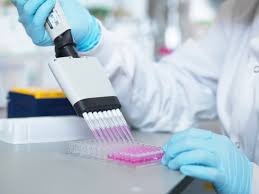ELISA assays are critical for laboratory applications in biomedical sciences. Today, they are often the tool of choice for measuring and detecting specific molecules for diagnostics, fundamental research, and drug discovery. Over the last few decades, ELISA services have flourished in the biomedical and life sciences domain. Besides, the advent of multiplexed ELISA assays has further skyrocketed its reach across disciplines. These developments have been reflected in innovations across domains, including molecular biology, immunology, diagnostics, and medicine. Specifically, areas such as virology, fungal biology, biotechnology, bacteriology, blood typing, oncology, food sciences, infectious disease surveillance, autoimmune diseases, vaccine development, and drug discovery have gained immense value from ELISA assay development services.
Collectively, ELISA assays have supported multiple applications for more than five decades. Besides, current techniques such as qPCR assay development have supplemented its growth. Hence, incorporating best practices for ELISA assay validation and development is critical. The current article explores ELISA lab best practices for high-quality results and efficient ELISA validation and development.
Assay consistency
Small assumptions can influence consistency between different assay plates run in a single assay. One such assumption is lot-mixing. Researchers may mix the lot to conserve reagents, which is incorrect. One should never mix components of different kit lots in a single run. Each assay has a defined performance level. Mixing different lots may generate suboptimal or inaccurate results. Hence, ensure lot-to-lot consistency for best ELISA results.
Aim for reproducibility
Reproducibility translates into reliability. However, mishandling or inconsistent sample or reagent preparation may affect reproducibility. Hence, bringing all reagents to room temperature before experiments is critical. Many assay reagents are temperature dependent, and thus bringing them to room temperature ensures consistent binding kinetics and color development. Besides, researchers should consistently handle and manage study samples. Consistency can be obtained by minimizing the freeze-thaw cycle, consistent sample collections, and optimizing sample dilution.
Assay accuracy
Increase ELISA assay accuracy by incorporating duplicates or triplicates for all data points, including sample, standard, and background wells. Running all points in replicates helps identify obvious outliers influencing the average in each point. More accurate results are critical to all bioanalysis to instill confidence in generated data and align their results with other published discoveries.
Must Read: Biochemical Assays in Drug Discovery: Enhancing Target Validation
Eliminate contamination
A lower coefficient of variability among study samples is vital for successful ELISA. Researchers can use fresh tips for each sample addition to lower the coefficient of variability. New tips prevent cross-contamination and increase data reliability. Notably, avoid pouring reagents back into the original bottle to eliminate contamination. Although the coefficient of variability is not too often calculated for each assay, it can be beneficial to evaluate the reliability and consistency of the assay results.
Reliable standard curve
For serially diluting the curve, use the indicated assay range to produce reproducible standard curves. Just adding points at both the curve ends will not increase assay sensitivity. The lower and upper ends of the curve depend on the unique properties of the antibodies used in ELISA assays. Ensure fresh standard curve preparation for each assay. Importantly, ELISA assays have a dedicated time frame to utilize the freshly prepared standard curves. Follow these recommendations while preparing standard curves.
Include all suggested controls and background.
All the suggested background wells should be used to ensure efficient assay working and appropriate troubleshooting if needed. Some assays may require multiple background and control wells. Hence, identify the unique needs of your experiment to include all necessary controls and backgrounds in your assay.
Use appropriate buffers and diluents.
Using the recommended diluents for sample and standard curve preparation yields the best results. While developing ELISA assays, developers often identify the optimal conditions for detecting samples and standard curve performance. All assay characteristics, including pH, ionic strength, and detergents are critical in developing the right environment for ELISA assays. Hence, following the recommended directions for diluents and buffers is crucial for the best ELISA results.
Follow the ideal temperatures, conditions, and incubation period.
The preparation incubation period is critical for complete color development. Temperature and shaking duration can greatly influence assay results. Cutting the incubation period may influence subsequent binding kinetics and alter the entire assay protocol. Besides, following proper shaking and plate incubation guidance is critical for enhancing assay performance and getting accurate results.
Optimal detection and accurate data analysis
Reading the assay plate at the correct wavelength and using appropriate data analysis software is necessary for optimal detection and accurate data analysis. A four-parameter logistic curve fit is ideal for accurate data analysis and sample data. Most plate readers today are equipped with this software. In case of any doubts, reaching out to the plate reader manufacturer is ideal.
Reduce background noise
Background noise can influence ELISA results. Generally, non-specific antigen or antibody binding may cause background noise. Besides, inadequate washing also results in background noise. Hence, thorough washing is necessary to remove the wash buffer and minimize background noise. Blocking agents specifically to prevent untargeted binding is recommended. Today, several commercially available blocking buffers are developed that contain unrelated small and large proteins or protein particles.
 WhatsApp Us Now
WhatsApp Us Now








